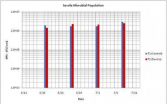(Press-News.org) Iron furnaces that once dotted central Pennsylvania may have left a legacy of manganese enriched soils, according to Penn State geoscientists. This manganese can be toxic to trees, especially sugar maples, and other vegetation.
The research, which quantified the amounts of manganese in soil core samples, was part of work done at the Shale Hills Critical Zone Observatory funded by the National Science Foundation.
"Our group's focus was to study the soil chemistry," said Elizabeth M. Herndon, graduate student in geosciences. "We saw excess manganese in the soil and decided that we needed to quantify the manganese and determine where it came from."
Typically, manganese in soils comes from the disintegration of the bedrock as soil forms. Bedrock in this area is shale and the average amount of manganese in the shale is about 800 parts per million. However, the researchers found 14,000 parts per million of manganese in some of the soil samples. This is more than 17 times as much manganese as in the bedrock.
The researchers sampled 21 sites along a ridge at Shale Hills. They took core samples from the surface down to bedrock. At 20 of the sites they found elevated manganese. The core samples, which are about 12 inches long, encompass about 7,000 years of soil formation.
"We needed to quantify how much extra manganese there actually was in the samples," said Herndon. "While soil formation puts manganese into the soil, chemical weathering and physical erosion remove manganese from the soil, so we used a mass balance model to account for these inputs and outputs."
The researchers found that "53 percent of manganese in ridge soils can be attributed to atmospheric deposition from anthropogenic sources." They reported their results online in Environmental Science and Technology.
"Because the amount of manganese in the soil was highest near the surface, the added manganese was very likely industrial pollution," said Herndon.
This area of central Pennsylvania was the site of numerous iron furnaces beginning in the late 1700s. While some furnaces stayed in operation into the 20th century, most were abandoned by the 1860s. The legacy of the ores and fuels they burned remained behind in the soil.
Although the researchers, who include Herndon, Lixin Jin, postdoctoral fellow in geosciences, and Susan L. Brantley, professor of geosciences and director of the Penn State Earth and Environmental Systems Institute, knew there was added manganese, they needed to show that the element came from industry. They looked at a location near a steel mill in Burnham, in Mifflin County and found a similar pattern of manganese concentrations in the soil suggesting that the steel mill was the source of the manganese.
They also examined datasets for soils across the United States and Europe and found that a majority of these soils have excess manganese. This may indicate that manganese pollution is not just a local phenomenon but could be widespread throughout industrialized areas.
Because manganese is naturally found in soils and is readily taken up and cycled by trees, the researchers looked to see if the pattern of manganese deposition matched that of areas where trees were manipulating the manganese. In those cases, trees move manganese from deep in the soil creating deficits near the bedrock, but concentrate the manganese nearer the surface. According to Herndon, the manganese pattern did not show a depletion near bedrock and the case for industrial pollution was strengthened.
Manganese is an exceptionally reactive element and is considered toxic if inhaled, but its presence in the soil, where it occurs naturally and is less likely to be inhaled, is not typically a danger to humans. Trees, however, may be adversely effected. While sugar maples can be detrimentally affected if they have a manganese deficiency, too much manganese can be toxic especially for saplings. High levels of manganese can also damage other vegetation and crops.
"Manganese oxides could also change the chemical properties of the soil," said Herndon. "Even if the sources of manganese pollution are no longer active, the remnants remain in the soil. I find it interesting that we have to consider the kinds of contamination left over from the past that might impact us today."
INFORMATION:
The National Science Foundation supported this work.
Iron legacy leaves soil high in manganese
2010-12-11
ELSE PRESS RELEASES FROM THIS DATE:
Twin study helps scientists link relationship among ADHD, reading, math
2010-12-11
Children with ADHD can sometimes have more difficulties on math and reading tests compared to their peers. A new study published in Psychological Science, a journal of the Association for Psychological Science, used identical and fraternal twins to look at the genetic and environmental influences underlying ADHD behaviors, reading, and math skills in children in an attempt to better understand the relationship among them.
Sara Hart, of the Florida State University, and her colleagues used twins enrolled in a long-term study of reading and math. Hart says by focusing ...
EARTH: Trade imbalance, America exports emissions to China
2010-12-11
Alexandria, VA – America has made great strides in recent years to reduce carbon emissions by increasing efficiency and turning to other, low or non-carbon energy sources. Meanwhile, carbon emissions in China have grown dramatically during that same time. EARTH looks at this disparity and asks the difficult questions about who is to blame when the coal China is burning is imported from "cleaner" countries and the emissions are produced to manufacture goods exported back to places with lower emissions.
Learn more about this eye-opening subject in January's featured article ...
Drugs are safe, active in patients normally ineligible for clinical trial
2010-12-11
ORLANDO - A two-drug combination is safe and active in newly diagnosed acute myeloid leukemia and myelodysplastic syndrome patients who are usually excluded from clinical trials because they have other illnesses or poor performance status - a measure of disease progression - researchers reported this week at the 52nd American Society of Hematology Annual Meeting.
"Our findings suggest current eligibility standards that prevent participation by these patients in phase I and phase II clinical trials might be inadequate," said Guillermo Garcia-Manero, M.D., professor in ...
New research reveals details of microbe's extraordinary maintenance and repair system
2010-12-11
Scientists have discovered how a network of repair proteins enables bacteria to prioritise the repair of the most heavily used regions of the DNA molecules that carry the instructions necessary for living cells to function.
The research, carried out by academics at the University of Bristol and published in Molecular Cell (Dec. 2010), reveals that there are greater similarities between the DNA repair systems of bacteria and humans than had been suspected.
When the chemical "letters" in a cell's DNA book of instructions are damaged the instructions become difficult ...
Poor breast cancer prognosis associated with presence of circulating tumor, cancer stem cells
2010-12-11
San Antonio - Metastatic breast cancer patients whose blood contains circulating tumor cells (CTCs) before or after treatment with high-dose chemotherapy and blood stem cell transplant have shorter survival periods, according to a new study by researchers at The University of Texas MD Anderson Cancer Center in Houston.
The findings were presented today in a poster session at the 33rd Annual CTRC-AACR San Antonio Breast Cancer Symposium.
In addition, patients with higher percentages of epithelial cells, or the presence of a specific cellular transition, had higher chances ...
HOXB7 gene promotes tamoxifen resistance
2010-12-11
A gene target for drug resistance, a triple-drug cocktail for triple negative breast cancer, and patients' risk for carpal tunnel syndrome are among study highlights scheduled to be presented by Johns Hopkins Kimmel Cancer Center scientists during the 33rd Annual CTRC-AACR San Antonio Breast Cancer Symposium, held Dec. 8-12. The information is embargoed for the time of presentation at the symposium.
HOXB7 GENE PROMOTES TAMOXIFEN RESISTANCE
(Presentation # PD05-10)
Many postmenopausal women with early-stage breast cancers who initially respond well to tamoxifen become ...
Trio of drugs may combat 'triple negative' breast cancer
2010-12-11
A gene target for drug resistance, a triple-drug cocktail for triple negative breast cancer, and patients' risk for carpal tunnel syndrome are among study highlights scheduled to be presented by Johns Hopkins Kimmel Cancer Center scientists during the 33rd Annual CTRC-AACR San Antonio Breast Cancer Symposium, held Dec. 8-12. The information is embargoed for the time of presentation at the symposium.
TRIO OF DRUGS MAY COMBAT "TRIPLE NEGATIVE" BREAST CANCER
(Presentation # PD01-05)
Working with cell cultures and mouse models, researchers at the Johns Hopkins Kimmel ...
Simple fingertip test may identify breast cancer patients at risk for carpal tunnel syndrome
2010-12-11
A gene target for drug resistance, a triple-drug cocktail for triple negative breast cancer, and patients' risk for carpal tunnel syndrome are among study highlights scheduled to be presented by Johns Hopkins Kimmel Cancer Center scientists during the 33rd Annual CTRC-AACR San Antonio Breast Cancer Symposium, held Dec. 8-12. The information is embargoed for the time of presentation at the symposium.
SIMPLE FINGERTIP TEST MAY IDENTIFY BREAST CANCER PATIENTS AT RISK FOR CARPAL TUNNEL SYNDROME
(Presentation # P2-14-09)
As many as half of postmenopausal women taking aromatase ...
Pitt study finds 'green' water treatments may not kill bacteria in large building cooling systems
2010-12-11
PITTSBURGH— Nonchemical treatment systems are touted as environmentally conscious stand-ins for such chemicals as chlorine when it comes to cleaning the water-based air-conditioning systems found in many large buildings. But a recent study by University of Pittsburgh researchers suggests that this diverse class of water-treatment devices may be ineffective and can allow dangerous bacteria to flourish in the cooling systems of hospitals, commercial offices, and other water-cooled buildings almost as much as they do in untreated water.
The two-year study by a team in Pitt's ...
Directed self-assembly of vertical nanotubes for biosensors, logic, nano-biofuel cells
2010-12-11
"Directed Self-Assembly of Vertical Nanotubes for Biosensors, Logic, and Nano-Biofuel Cells," will be the focus of NJIT's exhibit today
at the National Nanotechnology Innovation Summit 10 http://www.nsti.org/events/NNI/, at the Gaylord Center in Washington, DC. The event celebrates the 10th anniversary of the national nanotechnology initiative.
NJIT was the only university in New Jersey selected for this exposition featuring practical applications of nanoscience resulting from the last decade of federal funding under the National Nanotechnology Initiative (NNI). ...



